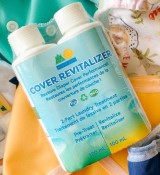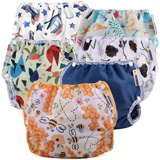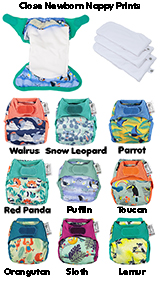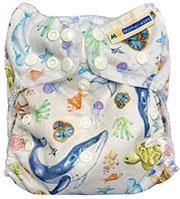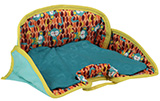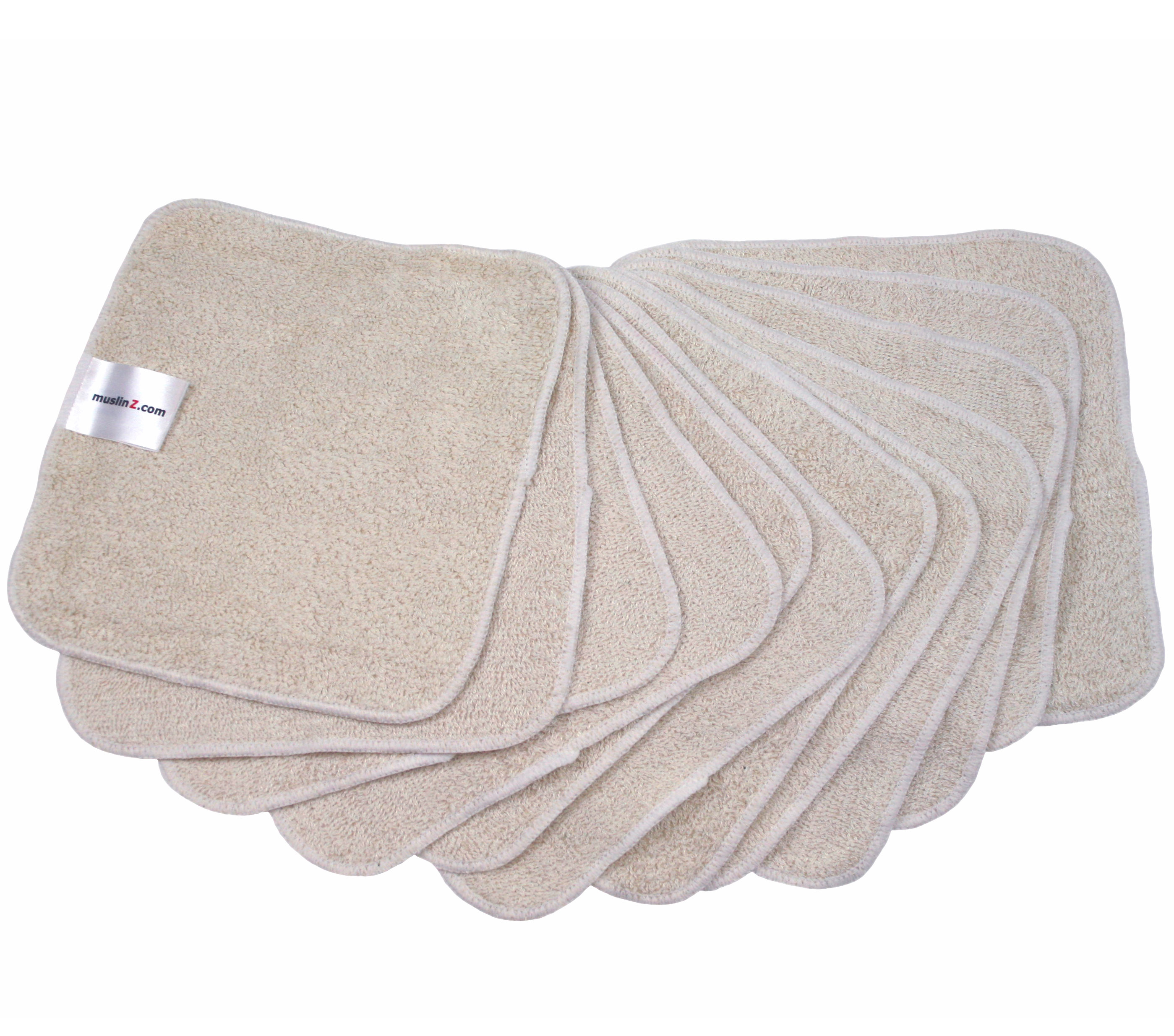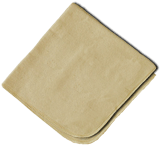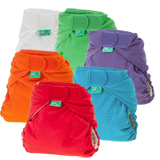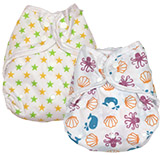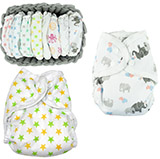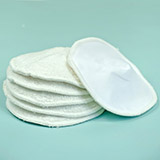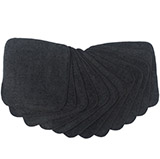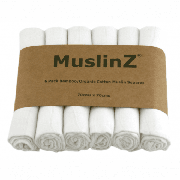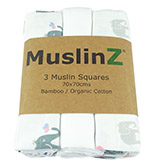How do I choose which nappies to use?
Download our Nappy Buying Guide ------->
This gives a brief overview iof the different nappy types, and their pros and cons.Alternatively, I've listed several factors that you may be considering in your choice of cloth nappy. Beside each one I've listed the nappy choices that I feel, from both my own experience and my customers' comments, may satisfy that particular need. Whilst my list is by no means comprehensive (there are so many different factors and so many permutations of nappy!), I hope this section will assist you in choosing the nappy system or combination of nappies to suit you and your baby. You may need to refer to the Glossary section. If you have any comments or recommendations for me to expand this section, I would be very pleased to hear from you. If you need further advice please feel able to email or phone with your query.Cost The cheapest systems are prefolds and terries, followed by One Size nappies - although you may need to purchases something smaller such as muslins or a small sized nappy such as Diddy Diaper, Kissaluvs or Bimble for a newborn (as the one-size nappies can be bulky) and perhaps later have to buy an XL size nappy if you have a big baby. The most expensive nappies are the All-In-Ones and Pouched Nappies such as Fuzzi Bunz or Happy Heinys, but the one size pouched nappies are cheaper overall although there will be a compromise on fit both at the newborn end where they may be bulky and not too goof on containment and also at the upper end where they may get outgrown. However, if you are looking for a one pice to put on type of nappy, ana all in one with detachable pads such as the Itti Bitti can be a lot more economical since you can just change the soiled inner pads rather than the whole nappy. A comparative costing of the recommended quantity for an average baby is highlighted for most nappy types in Saving . Ease of UseAn All-In-One nappy, or a Pouched Nappy System type such as the Fuzzi Bunz which are of very similar design to a disposable are probably the most easy to put on and take off, though with practise anything becomes easier! However the best containment will always be with a two part system and although it's only one extra layer to put on a nappy with a separate wrap will help with this. Terry nappies are perhaps the hardest to use initially as they require folding, but with a little practise you will soon master this - I always equate this to folding a letter to fit a window envelope, the first few times take a little effort to master, but after that it's quite easy. Generally a nappy with Velcro is easier to fasten quickly with re-adjustment later (also night times!), popeprs may be more of a stuggle particularly for the less nimble fingered as the poppers need lining up. With some styles eg Airflow wraps or Sandys nappies most of the poppers can often be done up first then pulled on. A traditional old style pull on pant may seem easy but it's worth remembering that if your baby has pooed on to the wrap then a wrap that opens out flat is a lot easier to deal with then pulling a pant down the leg.Quick to DryFlat nappies are the quickest to dry, they have no elastic to gather the fabric or Velcro fastenings to hold in moisture. Terries are undoubtedly the quickest to dry as they have the greatest surface area, as are the Disana Tie ons, followed by prefolds, with the bamboo fabric ones being slower. The quickest drying shaped and fitted nappies tend to be the types that open out more such as the non-Aplix version of the Nappy Nation (the extra thickness of the Aplix slows the drying), as all the flaps can be opend out for speed of drying, or nappies such as the Bimble or Bumble where the inner flap opens out. Bamboo, when in a shaped nappy is very slow to dry, in particular the nappies such as the Bamboozle have turned and top stitched seams giving 4 layers thickness and elastic gathering at the legs resulting in slower drying. Any All-In-One nappy where the absorbent inner cannot be separated from the backing such as the Kooshies Ultra will take a considerable time to dry, however there are Pouched Nappies giving the same one pice benfit for ease of putting on such as Happy Heinys, Fuzzi Bunz and Stuffables where the absorbent bit separates from the outer for quickest drying. The Itti Bitti system separates for washing, and the inner pads unpopper and fold giving a greater surface area for quicker drying. AbsorbencyFor each nappy I have indicated the general absorbency, hemp and bamboo fibres are more absorbent weight for weight than cotton. However any nappy can have its absorbency increased by adding extra Booster liners, or doubling up the nappy as required. Do experiment by adding layers if you get a leaking nappy, especially at night. For more information on absorbency, you will find a link to a US site with some comparative information for a large number of brands of nappies, (many of which are not yet available in the UK) on the Links page. For a wriggly babyVelcro fastening is generally easier to do up than poppers, however many popper fastening nappies such as the Mother-ease nappy can be done up first then pulled on as it is stretchy, as can the Air Rika wrap. An All-In-One or a stuffable nappy means only one layer has to go on eg Fuzzi Bunz/Stuffables. Terries and prefolds are perhaps best avoided at the wriggly and wanting to crawl off the changing mat stage if you are new to nappies and haven't got the practise in with an immobile newborn first, though if you have them they can be pad folded in a Velcro wrap or better - stuffed into a pouched nappy system.For a baby that can undo VelcroThe Mother-ease nappy, Kissaluvs or Sandys nappy and AirRika wrap all have poppers, or the Litewrap, Cot'n Wrap (not a stock item, please ask) or Imse VimseWool wrap have a popper AND Velcro so will will resist most fingers! The Disana Tie on is a nice cheap nappy that may be tied at the side and can thus baffle escapologists, likewise a pull on eg Disana pull on wool wrap may also be difficult for baby to remove. Somewhat surprisingly Nappi Nippas are usually a struggle for many babies to remove, since their natural reaction is to pull at the arms, this has the effect of digging the grippers in more firmlyFor a breastfed baby with more runny pooA shaped nappy with separate wrap is best at poo containment, as this gives two leg barriers. An all in one or pouched nappy such as Fuzzi Bunz may sound easier especially if you're new to nappies with a newborn but in reality having only one leg barrier and a newborn with slim legs that haven't yet got chubby will be more prone to leaks, so you'll need that second barrier in the form of a wrap over your nappy. A pad folded terry will be less successful at poo catching, even with the back fanned, however a carefully folded terry wrapped around and secured with a Nappi Nippa or pins, with the excess fabric rolled up the leg is, with practise very sucessful and can be just as succesful at containment as a shaped nappy. If using prefolds, wrapping the sides round and pinning or securing with a Nappi Nippa gives far better containment. A prefold or a terry nappy where the absorbent layer is pad folded as a strip or pad will be less successful at catching the poo and consequently may require more frequent changes of wrap, it is often best to fan the back for best containment. Full instructions on folding are available here: How to Nappy More than one baby of different ages in nappiesUse one size nappies plus wraps for each baby to suit, for example: prefolds, terries, Imse Diaper, or an adjustable nappy such as the Nappy Nation or the Tots Bots in a size 2 are also successful (if a little bulky) with babies from around 8lb simply by folding the front over outwards above the Aplix, and overlapping and securing the tabs with the wrap or for best containment with a Nappi Nippa. Twins We recommend one and half times the number of nappies if using the same nappy on twins or different sized babies (your machine will fill up quicker, so you'll wash more often and need less than you might expect - typical machine load is 15-18 nappies, so you'll need enough till they're dry), but we suggest one set of 4 wraps per baby to avoid running out of these.Click Here for some ideas as to how many nappies you might need
